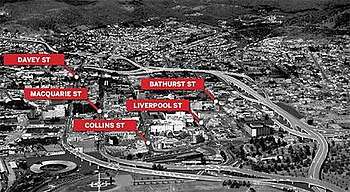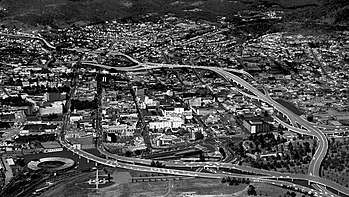Hobart Bypass
The Hobart Bypass is a proposed concept to bypass the Central Business District of Hobart, Tasmania. Currently, through traffic travels from the Tasman/Brooker Highways down the one-way Davey/Macquarie couplet to the Southern Outlet. As well as traffic concerns, there is also a call to build the bypass on the grounds that the current traffic arrangement cuts the central business district off from Hobart's waterfront.


Current alignment
At present, traffic proceeding to/from the Southern Outlet must pass through the one-way couplet of Davey and Macquarie Streets for access to the Tasman and Brooker highways. This current alignment was implemented in 1987 to coincide with the completion of the Sheraton. It was originally intended that the couplet system would serve as a stop gap measure prior to the construction of a freeway in Hobart's Transportation study of 1965.[1][2] Prior to this, all traffic in Hobart was 2-way.
Bypass proposals
Northside Freeway
The Northside Freeway was one of several traffic solutions proposed by US transportation and infrastructure consulting firm Wilbur Smith and Associates in their Hobart Area Transportation Study of 1965.[1] The proposed link was to extend from Grosvenor Street, Sandy Bay and the Southern Outlet at Davey Street and following the Hobart Rivulet and bypassing the CBD and crossing the Brooker Highway between Melville and Brisbane Streets, passing through the Queens Domain and connecting to the Tasman Highway.[1][3] The freeway was designed to be a raised freeway to avoid the sharp topographical features associated with the Queens Domain.[1]
Cross-City Tunnels
There has since been several proposals for a tunnel[4] under the city:
- Retired surveyor Max Darcey proposed a bored tunnel under Hobart connecting the Southern Outlet and the Tasman Bridge. Max's design was marked 'Tunnel Stage 1', 'Tunnel Stage 2', 'Alternative Stage 2' and 'Temporary through-traffic to Bridge (only if done in 2 stages)'. Tunnel Stage 1 arced north to north-westerly from the Southern Outlet to an interchange just north of Burnett St on the north-eastern side of the Brooker Hwy. Tunnel Stage 2 continued the gentle arc to be aligned with the Tasman Bridge suggesting new on and off-ramps would be built to connect the tunnel and the bridge. Alternative Stage 2 swung more sharply easterly before curving northerly to merge with the Tasman Hwy. The proposal was supported by the Lord Mayor of Hobart from 2011 to 2014, Damon Thomas. This proposal was assessed in a July 2011 report[3] by the Tasmanian Government Department of Energy Infrastructure and Resources. They reported: 'Data shows that there will continue to be a need for a large proportion of traffic to access the CBD itself, therefore stage one of the proposed tunnel [from the Southern Outlet to the Brooker Hwy] is likely to only remove about 15% of the traffic on the Macquarie Davey couplet during the morning peak and 14% in the evening peak.'
- In 2018, retired civil engineer Tony Denne, urban geographer Bob Cotgrove and former head of treasury Don Challen advocated a very similar plan to Max Darcy's plan (Alternative Stage 2), except that in their version, the tunnels between the Southern Outlet and Burnett St and between Burnett St and the Tasman Hwy are straighter, and unlike Max's proposal, it would feature junctures at which vehicles could join or leave the road, allowing access from suburbs such as Sandy Bay, Lenah Valley, and North, West and South Hobart.[5]
- A pair of two-lane one-way cut and cover tunnels under Davey/Macquarie Streets from the Brooker Hwy to the Southern Outlet.
- A single two-lane two-way cut and cover tunnel under Davey St from the Brooker Hwy to Sandy Bay Rd.
South West Link
Stage 1: Add an extra lane between Collins St and the South of Hobart along the north-western bank of the Hobart Rivulet. It requires a one-way tunnel/underpass approximately 170m in length from Gore St going under Macquarie St and emerging onto both Davey St and the Southern Outlet.
Optional Stage 2: Reduce the gradient of Molle St with an overpass of or a raising of the intersection with Goulburn St, and to convert Molle St to two-way between Melville St and Collins St.
Optional Stage 3: Flatten Hill St somewhat with an overpass of Warwick St.
Optional Stage 4: Build a ramp to just over a quarter of the way up Melifont St which goes into a tunnel emerging opposite Gordan Ave.
Optional Stage 5: Continue Springfield Ave through 184 Ripley Rd, curving westerly following the contours of the gully to meet with Lenah Valley Rd, with secondary connection to Creek Rd. This could also alternatively complement either of the Knocklofty bypass proposals discussed below, or stand on its own merits, as it would allow for bus services to be run from Devines Rd to the top of Springfield Ave to Lenah Valley Rd to Augusta Rd to Elizabeth St, which solves a major problem of the viability of more frequent bus services on the western periphery.
Bypass on the eastern foothills of Knocklofty
This proposal was from Elboden St via a bridge over Hobart Rivulet into a tunnel to Knocklofty Terrace to Pottery Rd. Hobart transport economist Bob Cotgrove commented that this proposal was likely to be too peripheral to justify the expense.
Bypass on the western foothills of Knocklofty
In the past, a bypass of the CBD has been suggested from McRobies Gully, South Hobart via Knocklofty Park to Lenah Valley.[3] It has been pointed out that this proposal would be virtually useless to anyone wanting to access the CBD from the northern suburbs due to the significant detour required through Cascade Rd.
Bypass behind Mt Wellington
Several Councillors from the Huon Valey Council, the Derwent Valley Council and the Hobart City Council have advocated the upgrade of four-wheel drive tracks behind Mt Wellington (kunanyi) between the Huon Valley and the Derwent Valley, stating that it would decrease Hobart through-traffic. However it is 28km in from the Huon Valley Council chambers to the Derwent Valley Council chambers via the proposed route, which makes it by far the furthest of any of the proposals. It is also certainly the most peripheral and would be the least used of any of the proposals. In May 2015, a report by consulting company Jacobs Australia stated that the proposed road provided only minor travel time savings, that accident rates would be higher and there would be a conflict between cars and trucks.[6]
Other options to reduce CBD traffic congestion
City-fringe car-parks
For example, a car-park near the Mcvilly underpass of the Tasman Hwy that was cross-subsidised from CBD car-parks would remove some of the traffic that comes into the CBD via the Tasman Hwy.
Ferry Services
Hobart ferry builder Bob Clifford has suggested a network of 17 ferry terminals. The state government announced in 2017 that it was considering a single peak-hour ferry crossing from Kangaroo Bay to Sullivans Cove.
Utilise the rail corridor on the western shore of the Derwent River
Proposals include:
- Steam engines on the existing track.
- Replacing the existing narrow-gauge track with a standard gauge track with overhead electrification. This was costed at $100 million to Glenorchy by GHD and $200 million to Austins Ferry by ACIL Tasman.
- Conversion of the track to a bus-way. This was the preferred option of transport experts working for the Department of State Growth.
Prioritise pedestrians and encourage active transport
Hobart has built a network of bicycle tracks and recently commenced work on a pedestrian bridge across the Tasman Hwy just over a hundred metres from the existing underpass, with another planned for the Brooker Hwy a mere 50 metres or so from the existing pedestrian underpass. The Hobart City Council elected in 2014 appointed a five-member infrastructure committee made-up of four councillors who are aligned to the Tasmanian Greens. The Hobart City Council recently released a report advocating further measures to prioritise pedestrians and active transport. In 2010, Danish architect and urban designer Jan Gehl who was commissioned to write a report[7] which similarly advocated a prioritisation of pedestrians. Since that report, Liverpool St in Hobart has been converted to one lane, making it more difficult for cars to drive around the Elizabeth St Mall.
Improve the relative attractiveness of buses on the existing road network
- Offer free bus services in peak-hours on congested routes.
- Provide better shelters, possibly with heating in the winter in the morning peak hour at popular suburban bus stops and interchanges, and in the afternoon peak-hour at the CBD bus stops.
- Impose higher parking fees in a way designed to have maximum impact on peak-hour congestion, such as a surcharge for putting your car into or taking it out of a CBD car-park in peak-hours.
- Trade fixed price car registration for either slightly higher petrol prices and/or congestion-pricing of major arterial roads and the Tasman Bridge.
- More parking where feasible near popular bus stops and interchanges.
Macquarie St Bus Lane
In early 2018 the Department of State Growth released a report[8] drafted together with Jacobs Consultants to widen the Southern Outlet by one lane through the Macquarie St and Davey St intersections and to add a lane to Macquarie St from Elboden St to Murray St. Under the proposal, Macquarie St would become one-way between Elboden St and Murray St, and the Southern Outlet and the new lane would be reserved for buses and left-turning traffic. The same report[8] also featured designs for a fifth lane (a reversible lane) for the Southern Outlet from Mt Nelson to Davey St.
Improve the efficiency of the Elizabeth St/New Town Rd/Main Rd bus route
- Either relocate the Elizabeth St Mall, overpass it, or underpass both the mall and the Hobart Rivulet, possibly going into an underground bus mall and an underpass of and possibly also a ramp up to and/or down from Macquarie St.
- Bypass Elizabeth St North Hobart by connecting Murray St to Augusta Rd via Andrew St (with roadside parking moved off-street), via a new road from Andrew St to Elphinstone Rd, and via an upgraded Mortimer Ave. Optionally also encourage cars to use the new bypass in peak-hours instead of Elizabeth St North Hobart by imposing a toll on Elizabeth St.
- Convert the Springfield bus interchange into a larger car-park and realign Main Road to allow the buses to bypass the existing bus interchange.
Tasman Hwy - City Links
Proposed single-lane one-way overpass of (or alternatively tunnel under) the Brooker Hwy from the Tasman Hwy to Collins St. It would allow buses to access the Elizabeth St Bus Mall, or motorists to access Market Place Car-Park or Argyle St Car-Park in 3 less traffic-lights, and take a load off of Davey St and the Railway Roundabout.
See also
References
- Hobart Area Transportation Study. Hobart, Tasmania: Wilbur Smith and Associates. 1965.
- "Kingston & Environs Transport Study" (PDF). Department of Infrastructure, Energy and Resources. 2006. Archived from the original (PDF) on 21 March 2012. Retrieved 30 April 2007.
- "Congestion in Greater Hobart - Response to issues" (PDF).
- "Hobart tunnel could be viable says economist". ABC News. Retrieved 4 March 2015.
- "Hobart bypass concept revived as solution for 'car-dependent' city's future".
- "Proposed tourist road from Derwent to Huon valleys gets revived push from Hobart alderman". 21 July 2016. Retrieved 24 July 2018.
- "Hobart 2010 Public Spaces and Public Life A city with people in mind" (PDF).
- "Southern_Outlet_-_Concept_Options_Report_Final.pdf" (PDF).